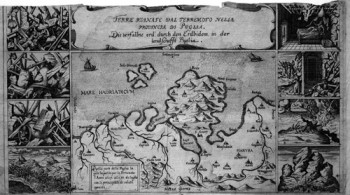Learning from distant disasters? On the cross-border media coverage of natural hazards in early modern Europe
 The research project examines the media coverage of natural disasters as cross-border moments of reflection and mobilisation in (Western) Europe in the 17th and 18th centuries. Instead of focussing on single extreme events (with the climax of the Lisbon earthquake of 1755), as is common in historical disaster research, the project aims to show the longer-term formation and transformation of disaster discourses across territorial and linguistic borders. Printed works in German, English, French, Italian and Latin will be analysed that deal in textual and visual form with extreme natural events (earthquakes and floods) in the respective other countries or language areas. The hypothesis is that an early modern European media culture of disaster emerged through societal teleconnections produced by the media.
The research project examines the media coverage of natural disasters as cross-border moments of reflection and mobilisation in (Western) Europe in the 17th and 18th centuries. Instead of focussing on single extreme events (with the climax of the Lisbon earthquake of 1755), as is common in historical disaster research, the project aims to show the longer-term formation and transformation of disaster discourses across territorial and linguistic borders. Printed works in German, English, French, Italian and Latin will be analysed that deal in textual and visual form with extreme natural events (earthquakes and floods) in the respective other countries or language areas. The hypothesis is that an early modern European media culture of disaster emerged through societal teleconnections produced by the media.Within this multilingual and cross-border research framework, fundamental questions of historical disaster research can be posed from a new perspective: Where and how did natural disasters cause identifications and interactions across the boundaries of status, gender and confession, and to what extent did they reinforce existing social differentiations? In these interactions, knowledge regimes – about humankind, the cosmos and God – were also activated and reconfigured. The disaster reports also commented on concrete measures for coping with acute crises within the here and now; to what extent did they also shift and expand religiously configured interpretational frameworks for coping with contingency?
From the perspective of those reporting and those affected, these cross-border disaster discourses can be analysed in four steps:
1. diagnoses: who suffers which misfortune, how is the relationship between man and God, man and man, and man and nature disturbed?
2. causes: Who is responsible for the catastrophe, who are the actors (God – humans – nature)?
3. consequences: How should the order of social status and gender, threatened and often disrupted by the catastrophe, be restored – through symbolic acts, religious practices and organisational measures?
4. long-distance effects: How does the catastrophe affect the perception of the world or the (discursively constructed) relationship between humans and "nature"? To what extent is nature rationalised and aestheticised and therefore (de- and re-)sacralised?
Methodologically, the project aims to test the potentials and limitations of computer-assisted multilingual text and image analysis. The digital corpus shall be examined using approaches of intertextuality and intervisuality for deliberate and non-intentional relations (text reuse, parallel re-creations, variations of topoi, etc.). By measuring the spectrum between reuse and "originality" in the cross-border disaster discourse, it is also necessary to ask, with regard to the target audiences, to what extent the reports and the accompanying engravings in the mirror of a distant disaster also deal with problems "on their own doorstep", and to what extent they change the imaginations of the "foreign" society in which the disaster occurred.
The research project addresses questions from the IEG's Research Groups Society, Religion and Digitality. It was conceived in 2024 and is to be resumed at the IEG following Joachim Berger's secondment to the Germanisches Nationalmuseum Nürnberg (2025–2027).
Picture capture and credits: (Unknown artist) Terrae Ruinate Dal Terremoto Nella Provincia Di Puglia. Die zerfallne erd', durch den Erdbidem, in der landschafft Puglia. Engraving to: Giovanni Valentino Poardi, Relatio Historica, Terrae Motus Horribilis, Qui In Regno Neapolitano, Provinciae Apuliae, 30. Iulii Anni M.DC.XXVII. Die Veneris Factus […].– Relation, Von dem grossen schröcklichen Erdbidem/ der sich im Königreich Napleß/ in der Landschafft Puglia den 30. Julii 1627. an einem Freytag begeben, Augsburg [1627]. Munich, Bayerische Staatsbibliothek: Einbl. V,8 ir. VD17 12:668864N, urn:nbn:de:bvb:12-bsb00102766-9.


